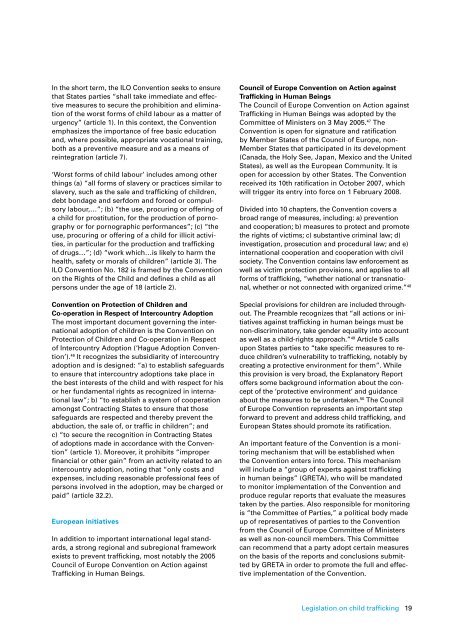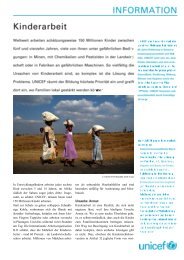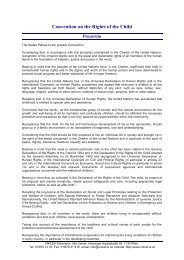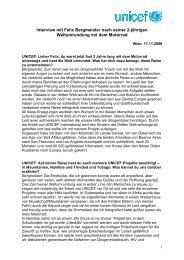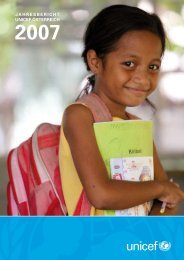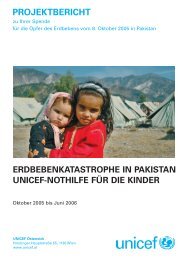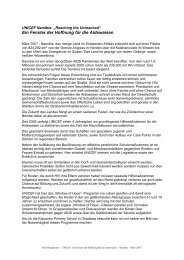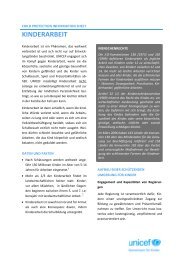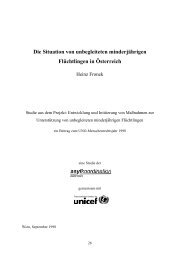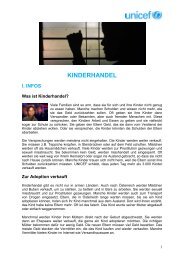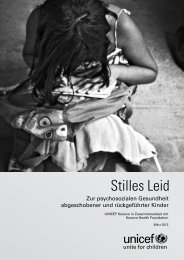Child Trafficking in Europe
Child Trafficking in Europe
Child Trafficking in Europe
You also want an ePaper? Increase the reach of your titles
YUMPU automatically turns print PDFs into web optimized ePapers that Google loves.
In the short term, the ILO Convention seeks to ensure<br />
that States parties “shall take immediate and effec-<br />
tive measures to secure the prohibition and elim<strong>in</strong>a-<br />
tion of the worst forms of child labour as a matter of<br />
urgency” (article 1). In this context, the Convention<br />
emphasizes the importance of free basic education<br />
and, where possible, appropriate vocational tra<strong>in</strong><strong>in</strong>g,<br />
both as a preventive measure and as a means of<br />
re<strong>in</strong>tegration (article 7).<br />
‘Worst forms of child labour’ <strong>in</strong>cludes among other<br />
th<strong>in</strong>gs (a) “all forms of slavery or practices similar to<br />
slavery, such as the sale and traffick<strong>in</strong>g of children,<br />
debt bondage and serfdom and forced or compulsory<br />
labour,…”; (b) “the use, procur<strong>in</strong>g or offer<strong>in</strong>g of<br />
a child for prostitution, for the production of pornography<br />
or for pornographic performances”; (c) “the<br />
use, procur<strong>in</strong>g or offer<strong>in</strong>g of a child for illicit activities,<br />
<strong>in</strong> particular for the production and traffick<strong>in</strong>g<br />
of drugs…”; (d) “work which…is likely to harm the<br />
health, safety or morals of children” (article 3). The<br />
ILO Convention No. 182 is framed by the Convention<br />
on the Rights of the <strong>Child</strong> and def<strong>in</strong>es a child as all<br />
persons under the age of 18 (article 2).<br />
Convention on protection of <strong>Child</strong>ren and<br />
Co-operation <strong>in</strong> respect of <strong>in</strong>tercountry adoption<br />
The most important document govern<strong>in</strong>g the <strong>in</strong>ternational<br />
adoption of children is the Convention on<br />
Protection of <strong>Child</strong>ren and Co-operation <strong>in</strong> Respect<br />
of Intercountry Adoption (‘Hague Adoption Convention’).<br />
46 It recognizes the subsidiarity of <strong>in</strong>tercountry<br />
adoption and is designed: “a) to establish safeguards<br />
to ensure that <strong>in</strong>tercountry adoptions take place <strong>in</strong><br />
the best <strong>in</strong>terests of the child and with respect for his<br />
or her fundamental rights as recognized <strong>in</strong> <strong>in</strong>ternational<br />
law”; b) “to establish a system of cooperation<br />
amongst Contract<strong>in</strong>g States to ensure that those<br />
safeguards are respected and thereby prevent the<br />
abduction, the sale of, or traffic <strong>in</strong> children”; and<br />
c) “to secure the recognition <strong>in</strong> Contract<strong>in</strong>g States<br />
of adoptions made <strong>in</strong> accordance with the Convention”<br />
(article 1). Moreover, it prohibits “improper<br />
f<strong>in</strong>ancial or other ga<strong>in</strong>” from an activity related to an<br />
<strong>in</strong>tercountry adoption, not<strong>in</strong>g that “only costs and<br />
expenses, <strong>in</strong>clud<strong>in</strong>g reasonable professional fees of<br />
persons <strong>in</strong>volved <strong>in</strong> the adoption, may be charged or<br />
paid” (article 32.2).<br />
<strong>Europe</strong>an <strong>in</strong>itiatives<br />
In addition to important <strong>in</strong>ternational legal standards,<br />
a strong regional and subregional framework<br />
exists to prevent traffick<strong>in</strong>g, most notably the 2005<br />
Council of <strong>Europe</strong> Convention on Action aga<strong>in</strong>st<br />
<strong>Traffick<strong>in</strong>g</strong> <strong>in</strong> Human Be<strong>in</strong>gs.<br />
Council of <strong>Europe</strong> Convention on action aga<strong>in</strong>st<br />
<strong>Traffick<strong>in</strong>g</strong> <strong>in</strong> human Be<strong>in</strong>gs<br />
The Council of <strong>Europe</strong> Convention on Action aga<strong>in</strong>st<br />
<strong>Traffick<strong>in</strong>g</strong> <strong>in</strong> Human Be<strong>in</strong>gs was adopted by the<br />
Committee of M<strong>in</strong>isters on 3 May 2005. 47 The<br />
Convention is open for signature and ratification<br />
by Member States of the Council of <strong>Europe</strong>, non-<br />
Member States that participated <strong>in</strong> its development<br />
(Canada, the Holy See, Japan, Mexico and the United<br />
States), as well as the <strong>Europe</strong>an Community. It is<br />
open for accession by other States. The Convention<br />
received its 10th ratification <strong>in</strong> October 2007, which<br />
will trigger its entry <strong>in</strong>to force on 1 February 2008.<br />
Divided <strong>in</strong>to 10 chapters, the Convention covers a<br />
broad range of measures, <strong>in</strong>clud<strong>in</strong>g: a) prevention<br />
and cooperation; b) measures to protect and promote<br />
the rights of victims; c) substantive crim<strong>in</strong>al law; d)<br />
<strong>in</strong>vestigation, prosecution and procedural law; and e)<br />
<strong>in</strong>ternational cooperation and cooperation with civil<br />
society. The Convention conta<strong>in</strong>s law enforcement as<br />
well as victim protection provisions, and applies to all<br />
forms of traffick<strong>in</strong>g, “whether national or transnational,<br />
whether or not connected with organized crime.” 48<br />
Special provisions for children are <strong>in</strong>cluded throughout.<br />
The Preamble recognizes that “all actions or <strong>in</strong>itiatives<br />
aga<strong>in</strong>st traffick<strong>in</strong>g <strong>in</strong> human be<strong>in</strong>gs must be<br />
non-discrim<strong>in</strong>atory, take gender equality <strong>in</strong>to account<br />
as well as a child-rights approach.” 49 Article 5 calls<br />
upon States parties to “take specific measures to reduce<br />
children’s vulnerability to traffick<strong>in</strong>g, notably by<br />
creat<strong>in</strong>g a protective environment for them”. While<br />
this provision is very broad, the Explanatory Report<br />
offers some background <strong>in</strong>formation about the concept<br />
of the ‘protective environment’ and guidance<br />
about the measures to be undertaken. 50 The Council<br />
of <strong>Europe</strong> Convention represents an important step<br />
forward to prevent and address child traffick<strong>in</strong>g, and<br />
<strong>Europe</strong>an States should promote its ratification.<br />
An important feature of the Convention is a monitor<strong>in</strong>g<br />
mechanism that will be established when<br />
the Convention enters <strong>in</strong>to force. This mechanism<br />
will <strong>in</strong>clude a “group of experts aga<strong>in</strong>st traffick<strong>in</strong>g<br />
<strong>in</strong> human be<strong>in</strong>gs” (GRETA), who will be mandated<br />
to monitor implementation of the Convention and<br />
produce regular reports that evaluate the measures<br />
taken by the parties. Also responsible for monitor<strong>in</strong>g<br />
is “the Committee of Parties,” a political body made<br />
up of representatives of parties to the Convention<br />
from the Council of <strong>Europe</strong> Committee of M<strong>in</strong>isters<br />
as well as non-council members. This Committee<br />
can recommend that a party adopt certa<strong>in</strong> measures<br />
on the basis of the reports and conclusions submitted<br />
by GRETA <strong>in</strong> order to promote the full and effective<br />
implementation of the Convention.<br />
Legislation on child traffick<strong>in</strong>g 19


